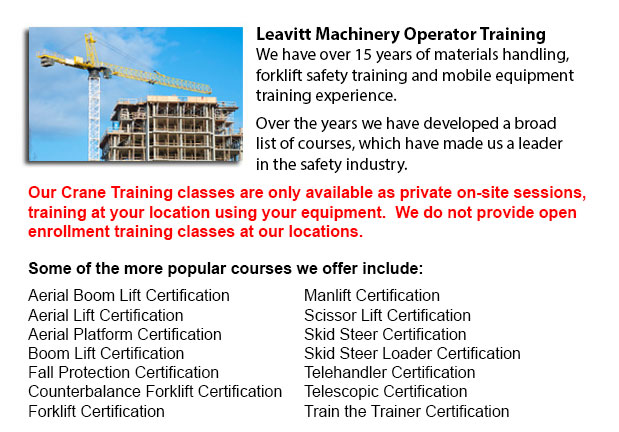
Oakville Overhead Crane Safety Training - Overhead crane safety training equips operators with skills and knowledge regarding crane safety measures, accident avoidance, materials handling, and machinery and stock protection. Trainees will learn the types of overhead cranes, their capabilities and their uses in different industry environments. For operators who are trained and licensed, the shift in liability moves to the operator from the company. Hence, the course emphasizes individual operator tasks.
Overhead crane safety training instructs operators in the proper techniques for carrying out checks. Two kinds of pre-shift inspection are the walk-around inspection and the in-depth inspection. These are vital daily routines that should be logged. Correctly recorded pre-shift checks help to protect the business from liability in case of an accident. Pre-shift inspections also prevent damage, expensive repairs and accidents. Operators learn how to designate a specific individual to handle inspections, how to report problems, and how to maintain the log book.
Checks should be done frequently and documented properly. The following should inspected while watching for common problems: increase in the throat opening, hooks for cracks, hoist ropes for corrosion, degree of twist, worn wires, loss of diameter, broken wires, kinks and bird caging, chemical and heat damage; chains for gouges and nicks, corrosion and cracks, twists, distortion, excessive wear, pits, stretching, damage from extreme heat.
The operator would get to learn the right ways about correct rigging measures. The process of rigging involves the understanding of the manufacturer's data plate, determining the material weight to be lifted, choosing the gear, and using safe practices to secure the load. The course include in detail the following: safe working loads, and the capacities of chains, ropes, hooks, shackles and slings.
It is essential to understand who may operate the cranes at your facility, the job's physical requirements, and operator credentials needed for specialized job and permits. Safety must be prioritized when operating in the vicinity of pedestrian traffic.
Safe crane operation involves responsibilities like undertaking visual inspections, checking for hydraulic leaks, testing the controls, checking the safety guards, examining the hoist rope and hook, limit switches and braking mechanisms. Proper reporting procedures are critical. These topics are all covered in depth in the course.
Correct moving and lifting methods with hoists and cranes are covered in the course. Operators would become knowledgeable in hand signals. Training involves how to attach the load, raise the load, abort a lift, set the load and unhook the slings.
Moving the load involves some steps: stopping and starting procedures, guiding and controlling the load, observing working conditions and working with signals. Operators need to know how to proceed in case of a power failure. The program covers methods for lowering the load and removing the slings, parking the crane, storage equipment, and securing an indoor and outdoor crane.
-
Oakville Crane Training Schools
Oakville Crane Training Schools - Our various Mobile Crane Operation programs are designed for skilled operators who needs re-certification or certification, and for inexperienced individuals who are seeking their very first job as an operator of a c... More -
Oakville Overhead Crane Certification
Oakville Overhead Crane Certification - The overhead crane certification course is a course that is designed to help trainees, even though they have language or literacy limits. The course consists of a classroom theory part and a practical hands-on... More -
Oakville Forklift Training Programs
Oakville Forklift Training Programs - If you are searching for work as an operator of a forklift, our regulatory-compliant forklift training programs provide exceptional instruction in various types and styles of forklifts, classes on pre-shift inspe... More -
Oakville Fall Protection Ticket
Oakville Fall Protection Ticket - The number one cause of death in the construction business come from fall-related accidents. There is more possibility for fall accidents depending on the types of work being performed within your workplace. Thus, be... More -
Oakville Zoom Boom Training
Oakville Zoom Boom Training - Zoom Boom Training focuses on correctly training potential operators on variable reach forklifts. The training objectives consist of gaining the understanding of the machine's physics and to define the job of the operato... More -
Oakville Aerial Lift Ticket
Oakville Aerial Lift Ticket - A boom truck is often recognized by the cable and telephone company vans that have the elongated arm folded over their roofs. Commonly, a bucket-like apparatus sits at the extension of extendable arms. Often referred to... More -
Oakville Scissor Lift Training
Oakville Scissor Lift Training - Scissor lifts need to be operated competently to be able to protect the safety of the machinery and the safety of people in the workplace. Operators who are skilled are trained to drive the specific model of scissor l... More -
Oakville Boom Lift Safety Training
Oakville Boom Lift Safey Training - Boom lifts are a type of elevated work platform or aerial lifting device which are commonly utilized in warehousing, construction and industry. Boom lifts could be made use of in almost whatever environment because... More

Forklift Certification Oakville
TOLL FREE: 1-888-254-6157
Oakville, Ontario
forkliftcertificationoakville.com
Email Us
About Us


